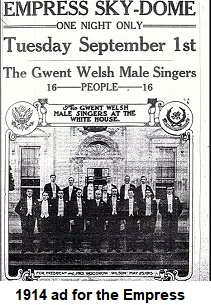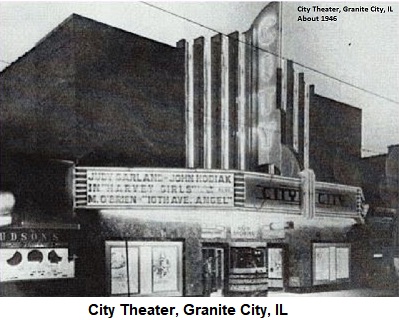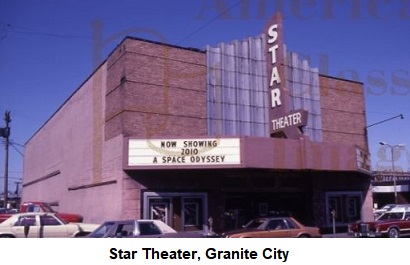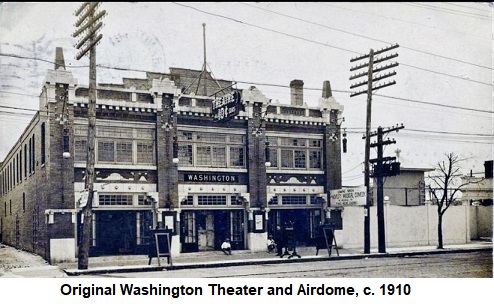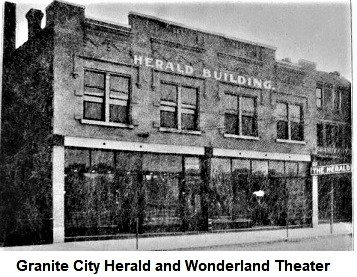Granite City Theaters
COLUMBIA
AIRDOME
The Columbia Airdome opened on March 27, 1910. It was located on D
Street, between 18th and 19th Streets in Granite City. It had a
seating capacity of 1,200. Opening night performance included Walter
A. Diefenbach in his famous Ethiopian Eccentricities and Miss
Florence Lawrence, a silent movie actress. Amateur night was held
every Thursday. Admission was 5 and 10 cents.
COLUMBIA
THEATER
The Columbia Theater opened on November 21, 1925. It was located at
24th & Madison Avenue in Granite City, Paul Lutostanski was the
owner of the theater. This theater later became the American Legion
prior to its being razed.
NEW COLUMBIA THEATER MAY OPEN OCTOBER 15
Source: Granite City Press Record, August 28, 1925
The Columbia Theater, now being built at 24th and Madison Avenue by
Paul Lutostanski, at a cost of $25,000, will be opened about October
15,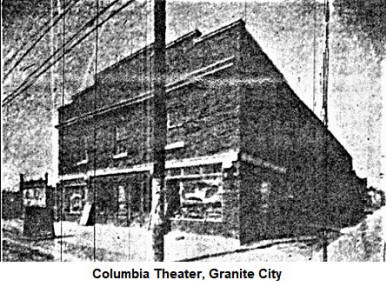
The owner states that the theater is to be a neighborhood one, which
will supply the pictures demanded by the community. A new picture
will be shown every night, and the pictures are to be the best
produced by the nationally known companies. The seating capacity of
the new place will approximately be 500, and the most up-to-date and
efficient ventilation system is being installed. The present
construction work is under the supervision of Paul Zerlan.
Llutostanski, a former newspaper man, states that he was manager of
a theater in Royalton, Illinois, for two years, when his lease on
the building expired.
NEW THEATER HAS TO TURN CROWDS AWAY
Source: Granite City Press Record, November 24, 1925
Courtesy of Granite City, IL Chronicle: A Historical Journey, on
Facebook
At the opening of the new Columbia Theater, located at 24th and G
Streets, Saturday night nearly 1,000 people were turned away from
the doors because there was not enough room to seat them. Three full
shows were given, and there was an attendance of over 1,500 people.
Music was furnished by the Granite City Band, led by John Tate. The
union objected to the use of the Jefferson Barracks Military Band.
In order to give more seating capacity, a balcony will probably be
erected, according to an announcement made by Paul Lutostanski, the
proprietor. Maner’s Orchestra has been engaged to furnish music each
evening. The pictures are changed every night, and matinees are
given from 2 to 5 o’clock on Saturdays, Sundays, and holidays. On
Thanksgiving Day, there is to be a continuous program of special
nature from 2 to 11 p.m.
ELECTRIC
THEATER AND PALACE OF MYSTERY
The Electric Theater and Palace of Mystery was established in 1903,
and was located at 19th and E Streets in Granite City. Very little
is known about this small theater. It is possible this theater was a
temporary venue or tent, or perhaps an Airdome.
ELECTRIC THEATER AND PALACE OF MYSTERY
Source: Granite City Press, 1903
Courtesy of Granite City, IL Chronicle: A Historical Journey, on
Facebook
An Electric Theater and Palace of Mystery has taken stand at 19th
and E Streets, and are playing to crowded houses every night. The
entertainment consists of animated, moving pictures, produced by
electrical appliances, and is well worth the price of admission, 10
cents.
EMPRESS
SKYDOME/GRAND AIRDOME
The Empress Skydome opened June 8, 1914, and was located at 19th &
State Street in Granite City. The outdoor, moving picture theater
showed Kinemacolor moving pictures on Mondays and Saturdays, and
featured live vaudeville performances every night.
THE GRAND AIRDOME
The Grand Airdome was opened on April 24, 1915. It was formerly the
Empress Skydome. The airdome was located at 19th & State Streets in
Granite City.
GRAND
THEATER/PRINCESS THEATER/RIALTO THEATER/CITY THEATER/STAR THEATER
The Grand Theater was located at 1919 State Street (near Nineteenth
Street) in Granite City. It was under the management of Mrs. Frank
J. Guth, and even though it was not fully completed, the theater
opened on Saturday, March 11, 1916, with the 5-reel master picture,
“The Thoroughbred” and a 2-reel Keystone comedy featuring Sid
Chaplin. Music was provided by a Wurlitzer player piano. Admission
was 5 and 10 cents. Mrs. Guth, was managed the theater, died March
9, 1917, following an illness and operation. She was 29 years old,
and left behind her husband and one child.
PARTNERS TO OPEN NEW THEATER
Source: Granite City Press Record, February 11, 1916
Courtesy of the Granite City, IL Chronicle: A Historical Journey on
Facebook
On the fourth day of October, 1915, Frank J. Guth and Clyde Adams
entered into a co-partnership to become partners in operating a
moving picture and vaudeville theater on State Street. Later, they
began the construction of a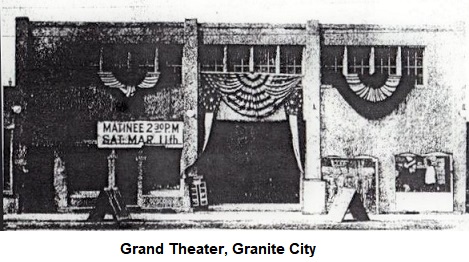
WORK ON THEATER STOPPED BY MAYOR
Source: Granite City Press Record, October 22, 1915
Courtesy of the Granite City, IL Chronicle: A Historical Journey, on
Facebook
Believing that the construction of the building was a big risk in
case of fire, and also that the dimensions and material used did not
conform with the city ordinances, which provide for fireproof
buildings within the fire zone, Mayor J. C. Steele this morning
ordered work upon the new winter theater, being constructed by F. J.
Futh and others, stopped. The building was being erected upon State
Street, and was contemplated to cover a full city lot, with a
seating capacity of several hundred. When the matter of the building
permit was brought to the attention of Mayor Steele, he granted
permission for the erection of the building upon being assured that
it was to conform with all city requirements. However, when Mayor
Steele inspected the building yesterday, and saw that the building
was to be of frame construction, with a coating of material similar
to plaster upon it, he ordered the builders to stop work, and not to
proceed until the building conformed entirely with the ordinances.
The building was planned to be a winte4r theater, and was to be
operated throughout the season by the owners and managers. Mayor
Steele received the hearty approval of a large number of business
men, some of whom have their places of business adjoining the
proposed theater, when he ordered work upon the building stopped
until all requirements were met. Those who were interviewed declared
the building appeared to be more or less of a fire trap, and were
afraid its presence in close proximity with their buildings would
increase fire insurance rates. Mayor Steele said last evening: “I am
heartily in favor of all the business institutions of a desirable
nature the city can secure, and really believe a second theater
would be the means of giving local patrons better pictures and
shows. However, I am determined that the city building ordinances
shall be compiled with, and for that reason I ordered work stopped
upon the new theater building. Nothing will proceed with my
permission until every building ordinance is complied with.
THE PRINCESS THEATER
The former Grand Theater opened as the Princess Theater in 1918. It
was managed by Mr. and Mrs. P. F. Lowery of Salem, Illinois.
OLD GRAND THEATER HAS NEW NAME
Source: Granite City Press, 1918
Courtesy of the Granite City, IL Chronicle: A Historical Journey, on
Facebook
Now that the old Grand Theater on State Street is under new
management and has a new name, being called “The Princess,” it has
been deemed advisable to give the place a new coat of paint and a
general remodeling. The work has been done on a thorough scale, and
the place is hardly to be recognized when one steps inside. New
lights have been installed, and they show up the tints of green and
gold admirable.
The “Princess” is showing to crowded houses every night, giving its
patrons some very good all-picture shows at popular prices. The
place is under the management of Mr. and Mrs. Lowery of Salem,
Illinois.
RIALTO THEATER
The Rialto Theater, formerly the Princess, was opened Saturday,
September 27, 1919. The proprietor was Alfred S. Cote. The opening
show was a Hall Caine special feature, “The Woman Thou Gavest Me,”
together with a new Fatty Arbuckle comedy titled, “Back Stage.”
FORMER PRINCESS THEATER TO RE-OPEN
Source: Granite City Press
Courtesy of the Granite City, IL Chronicle: A Historical Journey, on
Facebook
Alfred S. Cote, proprietor of the Liberty Theater in East St. Louis
and the Madison Theater, as well as a heavy stockholder in a number
of St. Louis theaters, is to open up the old Princess Theater on
State Street in Granite City. Mr. Cote expects to open up the
theater about September 15th.
NEW THEATER TO OPEN SATURDAY
Source: Granite City Press, September 26, 1919
Courtesy of Courtesy of the Granite City, IL Chronicle: A Historical
Journey, on Facebook
Opening Saturday night with an excellent program, featuring the Hall
Caine special feature, “The Woman Thou Gavest Me,” together with a
new Fatty Arbuckle comedy entitled, “Back Stage,” the new Rialto
Theater, formerly the Princess, will present an inviting interior to
the theater-going public of Granite City. The Rialto, which is now
under the management of Alfred S. Cote, has been entirely remodeled
and re-decorated at an expense of over $7,000. A brand new floor has
been laid, with special noiseless runners on the aisles. The theater
has been entirely decorated in a soft blue tone, lending a
comfortable atmosphere and aiding one’s enjoyment of the pictures.
Mr. Cote has purchased the lot and building, and intends to make the
Rialto popular by offering only the very finest of motion picture
features. Courteous treatment and ceaseless attention to the comfort
of patrons are an important part of the Rialto’s policy.
Among the producers whose new output will be seen exclusively at the
Rialto are Paramount-Artcraft, Goldwyn, Select, Realart, Vitagraph,
Pathe, Word, Mutual and Universal Pictures. The stars who will
appear in their newest productions only at the Rialto comprise such
favorites as Charles Ray, Marguerite Clark, Mabel Normand, Tom
Moore, Vivian Martin, Elsie Ferguson, Pauline Fredericks, Madge
Kennedy, June Elvidge, Billie Burke, Wallace Reid, Fatty Arbuckle,
Geraldine Farrar, Will Rogers, Louis Hennison, Alice Brady, Mary
Miles Minter, Virginia Pearson, Harry Carey, William Desmond, Harry
Morey, Alice Joyce, Earle Williams, Bessie Love, Gladys Leslie,
Marguerite Fisher, Bessie Barriseale, and many others.
The policy at the Rialto will be a change of program daily, with the
evening performance starting at 6:30 p.m., and the Sunday
performances running continuously from 2 p.m. to 11 p.m. Underlined
for Sunday is the famous Charles Klein drama, “The Gamblers,”
featuring Harry Morey, together with a Larry Semon comedy, “Between
the Acts,” and one of those interesting Bray cartoons.
NEW SHOW HAD BIG OPENING CROWD
Source: Granite City Press Record, September 30, 1919
Courtesy of Granite City, IL Chronicle: A Historical Journey, on
Facebook
The Rialto Theater, formerly the Princess, which opened under the
management of A. S. Cote, last Saturday evening, enjoyed a large
attendance for the opening night. The lobby was fragrant with the
odor of many baskets of beautiful flowers presented by friends of
the new management, and the patrons of the new show were greeted at
the ticket window by a familiar face to the local theater goers,
Mrs. Faythe Costley Stroud being the ticket seller. A good program
filled out the opening performance at the Rialto, and Mr. Cote
assured his patrons that they will always find the attractions there
to be the best obtainable. The program for the show is to be found
in the Press Record each issue.
LILLIAN AMUSEMENT COMPANY TO TAKE OVER RIALTO THEATER
Source: Granite City Press, July 13, 1920
Courtesy of the Granite City, IL Chronicle: A Historical Journey, on
Facebook
The Lillian Amusement Company, operating the Washington Theater, by
Louis Landau Jr., has taken over the Rialto Theater. Mr. Landau will
in the future manage both houses. The Washington Theater will be
devoted mostly to vaudeville, and after some remodeling has been
done to the Rialto, the house will be open for the fall season, on
or about Sunday, August 29th, with a good orchestra and big feature
pictures. It will be the policy of Mr. Landau to maintain at both
houses the high standard of always a good show, and at no time will
the standard of always a good show be cut, owing to the fact that
the management is in control of both houses, for Mr. Landau, the
manager, realizes that he would only be hurting his own business in
not trying to give the public of Granite City more than their
moneys’ worth.
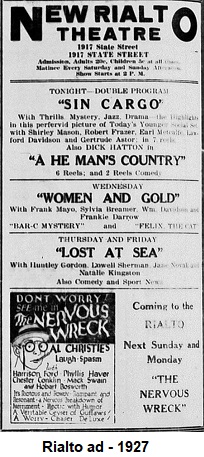
The vaudeville will be booked out of the Western Vaudeville Managers
Association of Chicago, in conjunction with the Junior Orpheum
Theaters of the United States, and will be booked out of New York.
The vaudeville circuit shows here will be the same as seen at the
Rialto Theater in St. Louis; also the Grand Opera House, the
Columbia Theater, and the Orpheum Theater of St. Louis.
For the benefit of the public, who are not familiar with prices paid
for vaudeville, Mr. Landau wishes to state, and his records are open
to anyone, that the vaudeville that will be booked here will average
from $500 to $700 per week. The pictures average about $75 per day,
and in some cases more. The expense in running a theater is more
than the average person thinks. As the old saying goes, “It is not
all gold that glitters,” and in view of the fact by having both
houses under one management, expenses could be cut some and add more
to the show.
RIALTO THEATER BEING REMODELED FOR FALL
Source: Granite City Press Record, June 17, 1921
Courtesy of the Granite City, IL Chronicle: A Historical Journey, on
Facebook
Work of remodeling the Rialto Theater on State Street was started
Wednesday by Hawley & Herrin, local builders and contractors. The
entire work is being done by the Granite City men, and will be
finished for Labor Day opening. The theater will be heated by a new
system of gas radiators, which will keep the temperature at 70
degrees in the coldest weather. The first large show booked by
Manager Landau is the Vogels Minstrels of fifty people and a band of
fifteen men. They will show here one night only, Thursday, September
8th. There will be a big street parade and free concert at 8 p.m. in
front of the theater in the evening. It will be the manager’s policy
to have one large traveling show each week at the Rialto after the
opening. The public can depend upon a new and sanitary playhouse
after Hawley & Herrin have finished.
RIALTO THEATER OPENS TONIGHT
Source: Granite City Press Record, September 9, 1921
Courtesy of the Granite City, IL Chronicle: A Historical Journey, on
Facebook
With the opening of the New Rialto Theater on State Street tonight,
the theatergoers of Granite City will have the opportunity of seeing
a first-class show in the appearance of the big minstrel
performance, and they will also have their first glimpse at the
beautiful interior of the newly remodeled showhouse. Manager Landau
has spared no expense in practically rebuilding the interior and in
its decorating, the seats have all been rearranged, new lighting and
heating fixtures installed, everything shines and glows with paint
that is spic and span.
In the lobby, just a little at the right of the box office as you go
in, is a mighty comfy lounge room, with a nice rug and big cushioned
chairs and a couch that just spells ease. Newly padded carpets lead
up the stairs, and no more will the audience be annoyed by the boys
big and small taking those steps two at a time, just at the most
tense moment of the picture or exciting point of the play.
The policy of the New Rialto, Mr. Landau states, will be to give the
very latest and best shows at low prices, and nothing has been left
undone to give Granite City a theater that ranks in the first class.
The latest big picture releases that show in other cities at big
prices will be shown at the new theater at a popular price, Manager
Landau states, and an early announcement will be made of some of the
road shows that are to play here during the coming season.
Granite City boosters that admire a good show can do two things by
attending the opening tonight – they can show their appreciation of
the efforts put forth by Mr. Landau, and they will also see a mighty
big show.
STAGE SHOW AT RIALTO THEATER
Source: Granite City Press Record, unknown date
Courtesy of the Granite City, IL Chronicle: A Historical Journey, on
Facebook
George B. Flint’s 1927 editor of “Modes and Models” will be
presented at the Rialto Theater, Monday and Tuesday evenings. The
stage show is a miniature extravaganza praising the “American Girl,”
and shows the evolution of fashion from the time of Eve to the
present day, and then jumps ahead to 1927, giving the artist’s idea
of what will then be the vogue. The songs are all special, and are
by Billy Baskette, who wrote, “Ray and His Chevrolet,” “Talking to
the Moon,” “Hoosier Sweetheart,” and numerous other hits as well as
the entire score of Earl Carroll’s “Vanities of 1927.” Plenty of pep
and dancing is displayed, and the numerous musical numbers under the
direction of Estelle Flint is the type that makes one whistle. Five
changes of setting, special electric lighting effects, and gorgeous
wardrobe make this a most pretentious offering.
CITY THEATER
The Rialto Theater was renamed the City Theater in 1948. The
building was later used as a church. The building once again became
a theater in the 1980s, and was named the Star Theater. It wasn’t
long, however, before the wrecking ball did its work. The site is
now a parking lot.
THE STAR THEATER
The Star Theater (formerly the City Theater), opened in the 1980's,
but it wasn't long before the theater was razed. The site is now a
parking lot.
GEM THEATER
Little is known about this early theater in Granite City. It may
have occupied the same location as the Wonderland Electric Theater.
The Gem was open in at least December 1909.
GRANITE CITY CINEMA
The Granite City Cinema, located at 1243 Niedringhaus Avenue in
Granite City, opened in August 20, 2010. The 4.6-million-dollar
theater was designed by Trivers Associates of St. Louis and
Edwardsville, and was built by the city government with money from a
downtown tax-increment financing district, using American steel and
union labor. It is managed by St. Louis Cinemas. The three-screen
theater is all digital and 3-D capable. It has a seating of 500.
KEN THEATER
The Ken Theater, located at 3120 Nameoki Road in Granite City, was
opened in 1948 and closed in 1958. The opening film at the Ken
Theater was “This Time for Keeps” starring Esther Williams and Jimmy
Durante. After closing, the theater was converted into the Rose Bowl
Restaurant. The Rose Bowl Restaurant was sold, and then was
destroyed by fire. The building was later demolished and a
convenience store was built on the site. Later, Charly’s Restaurant
was constructed on the site.
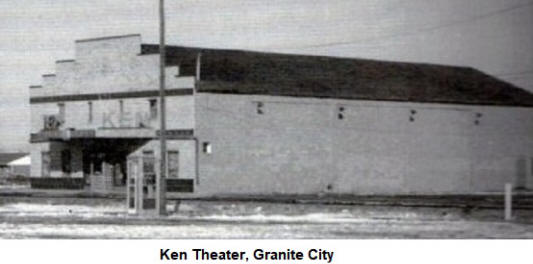
LINCOLN PICTURE SHOW
The Lincoln Picture Show was located at 942 Pacific Avenue in
Granite City. It was established on Saturday, November 15, 1924, by
owner A. Vartanian. Prices were 5, 10 and 15 cents.
MAJESTIC
THEATER
The Majestic Theater was located on Delmar Street, near 19th Street,
in Granite City. The theater opened on Saturday, March 7, 1908. This
may have been the same location as the Wonderland Electric Theater.
MAJESTIC THEATER
Source: Granite City Press, date unknown
Courtesy of the Granite City, IL Chronicle: A Historical Journey
The Majestic Theater on D Street is making extensive repairs this
week. A raised floor is being laid at the proper angle to afford a
good view of the stage, and the entire arrangement is being
remodeled to make better and greater seating capacity. The
electrical room is built outside the main building, thus increasing
the seating capacity by forty. Saturday evening, a high class
vaudeville, with special musical features, will be introduced. The
Majestic expects to give the amusement-loving public the best
entertainment that money can produce at the nominal admission of ten
cents.
NAMEOKI TWIN CINEMA
Located in Granite City’s main shopping plaza, but a stand-alone
structure, this twin theater, contemporary in design, opened on
Friday, July 27, 1973. The opening show was “Pat Garrett & Billy the
Kid,” and “Class of ’44.” There were plans to expand the theater to
four screens, but this never happened. The theater was under the
management of the Mid-American Theaters chain. The theater closed in
2004 and was demolished for a new shopping strip mall and Applebee’s
Restaurant.
WASHINGTON THEATER AND THE WASHINGTON AIRDOME
The original Washington Theatre, located at 1330 – 1332 19th Street
in Granite City, was constructed in 1910 for the Lilian Amusement
Company, and seated about 750. Several years later a balcony was
added, making a seating capacity of 1,200. The theater was designed
by the architectural firm Charles Pauly & Son, and was managed by
Mr. Landau.
The Washington Airdome, an outdoor theater, was constructed in 1911,
to the right of the Washington Theater. On hot, summer nights,
patrons would be entertained in the Airdome instead of the hot
theater. The Airdome was also used for labor rallies and political
meetings. It was packed on October 9, 1912, when Woodrow Wilson,
Democratic presidential candidate, spoke there. The Airdome remained
in operation at least into the 1920s, when the third Washington
Theater was constructed.
The original Washington Theater was closed in 1923 when a new
Washington Theatre was built to the rear of the existing theatre, at
a right angle. Part of the original theater became the entrance hall
to the new auditorium, with the rest of the original theater going
to retail space.
The second Washington Theatre was opened December
21, 1923, and was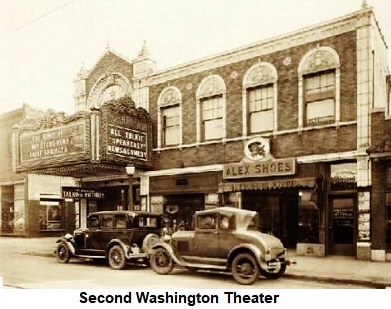
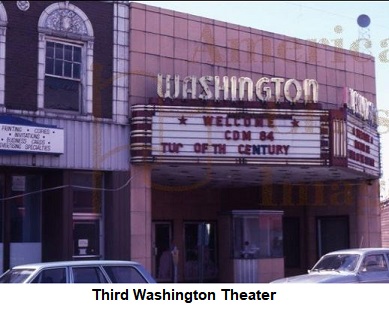
A third Washington Theater was constructed just to the right of the
second Washington Theater, on the property formerly occupied by the
Washington Airdome. It was located at 1346 19th Street in Granite
City.
The Washington Theater was acquired in December 1928 by the Skouras
Theatres chain. In late-1929 it was taken over by the St. Louis
Amusement Co. Still later, the theatre was part of the Fanchon &
Marco chain. It was taken over by Arthur Enterprises in 1957. The
theatre was remodeled again in 1975.
The Washington Theatre operated until abt. 1980. The building was
used for live events for a while, but was razed in 1993 to make way
for the Madison County Transit station at 19th and Edison.
WILSON
THEATER
The Wilson Theater was located at 924 Pacific Avenue. This theater
opened on February 12, 1925, with Peter J. Schoyan as owner. The
first movie was “The Fighting Sap.” The theater closed June 8, 1925
for remodeling, and reopened June 13, 1925 under new management –
mostly business men of Lincoln Place. A new ventilation system was
installed. The theater (with a new address of 943 Pacific) had
another reopening on September 17, 1926, under new management.
POLICE OFFICER TO OPEN WILSON THEATER
Source: Granite City Press Record, February 10, 1925
Courtesy of Granite City, IL Chronicle: A Historical Journey, on
Facebook
Peter J. Sehoyan, a night-rider on the local police force, announces
today that he is opening on Thursday, Lincoln’s birthday, a new
moving picture house in Lincoln Place, which is to be known as the
Wilson Theater, seating about 300, and showing first-class pictures
every night, with special catering to the residents of that
district, at the prices of 10 and 20 cents. “Fighting Sap,” an F. H.
O. production, will be his initial picture. He has films signed up
more than a month in advance with F. B. O. Producer Distributers,
Fox, Vitagraph, Universal, and Metro Studios.
Sehoyan gives an explanation of the appearance of this second
theater in Lincoln Place by saying that so many had come to him with
objection against the Lincoln Theater, that he had resolved to put
up one that would pass inspection, and be perfectly safe and
sanitary in every respect.
WONDERLAND ELECTRIC THEATER
The Wonderland Electric Theater was located at 1834 Delmar Street in
Granite City. This theater was established on August 03, 1907, with
proprietors McPherson & Remaley, and John McPherson as manager. The
building also housed the Herald (1836 Delmar), taking up space on
the left side of the building, while the theater occupied the right
side of the building.
NEW PICTURE SHOW
Source: Granite City Herald, August 01, 1907
Courtesy of the Granite City Chronicle: A Historical Journey, on
Facebook
John McPherson has rented the room adjoining the Herald office on D
Street, and will open the Wonderland Electric Theater Saturday. The
bill will be changed daily, and a pleasing entertainment furnished.
The pictures will be interspersed with illustrated songs. T. J.
Williams, the well-known singing comedian, and the Davis sisters of
St. Louis, have been engaged for the season. Admission 5 cents.
Thank you to the Granite City, IL, Chronical: A Historical Journey, on Facebook, for giving permission to use their information and photos on Granite City Theaters!
